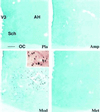Potential brain neuronal targets for amphetamine-, methylphenidate-, and modafinil-induced wakefulness, evidenced by c-fos immunocytochemistry in the cat
- PMID: 8943072
- PMCID: PMC19505
- DOI: 10.1073/pnas.93.24.14128
Potential brain neuronal targets for amphetamine-, methylphenidate-, and modafinil-induced wakefulness, evidenced by c-fos immunocytochemistry in the cat
Abstract
Much experimental and clinical data suggest that the pharmacological profile of modafinil, a newly discovered waking substance, differs from those of amphetamine and methylphenidate, two classical psychostimulants. The brain targets on which modafinil acts to induce wakefulness, however, remain unknown. A double-blind study using the protooncogene c-fos as experimental marker in the cat was, therefore, carried out to identify the potential target neurons of modafinil and compare them with those for amphetamine and methylphenidate. Cats were sacrificed after a single oral administration of amphetamine, methylphenidate, or modafinil at equivalent doses for wake induction (1, 2.5, or 5 mg/kg, respectively) and brain sections examined for Fos by immunocytochemistry. Administration of either amphetamine or methylphenidate evoked Fos-like immunoreactivity in a large number of neurons in the striatum and whole cortex, especially in the caudate nucleus and mediofrontal cortex, which are known to be dopaminergic targets. In contrast, administration of modafinil resulted in the labeling of few cells in these structures, but did induce marked Fos labeling in neurons of the anterior hypothalamic nucleus and adjacent areas. These results provide evidence for the potential brain targets of modafinil, which differ from those of amphetamine or methylphenidate, and suggest that modafinil induces wakefulness by mechanisms distinct from those of the two stimulants.
Figures




References
-
- Bastuji H, Jouvet M. Prog Neuropsychopharmacol Biol Psychiatry. 1988;12:695–700. - PubMed
-
- Duteil J, Rambert F A, Pessonnier J, Hermant J F, Gombert R, Assous E. Eur J Pharmacol. 1990;180:49–58. - PubMed
-
- Hermant J F, Rambert F A, Duteil J. Psychopharmacology. 1991;103:28–32. - PubMed
-
- Lin J S, Roussel B, Akaoka H, Fort P, Debilly G, Jouvet M. Brain Res. 1992;591:319–326. - PubMed
-
- Morgan J I, Curran T. Trends Neurosci. 1989;12:459–462. - PubMed
Publication types
MeSH terms
Substances
LinkOut - more resources
Full Text Sources
Other Literature Sources
Miscellaneous

